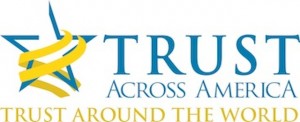Is loneliness at the top a trust buster? You bet. But don’t believe me, just read this Wall Street Journal article and pay particular attention to #3.
We must not forget that our organization’s leaders are humans first and executives second. How can we expect leaders to be trustworthy when rising in the ranks impedes the growth of trust?
I’ve spoken to CEOs who joke about how lonely it is at the top, but I never stopped to think about why. Imagine getting to where you are only to find that you are forced to trust fewer people as more try to take advantage of your position?
If building organizational trust rests squarely on the shoulders of leadership, this Catch 22 must be overcome. Leaders can start by availing themselves of the myriad of resources (many free) to avoid the “loneliness trap” by building organizational trust in incremental steps.
Trust Across America-Trust Around the World has spent six years sourcing trust tools and bringing them together on our website- books, magazines, videos, reports, speakers, and even a master research bibliography. If you are the leader of an organization and feeling the “loneliness at the top” and diminishing trust, please stop by. If you can’t find what you are looking for, drop us a note at barbara@trustacrossamerica.com . We’ll be glad to help (no strings attached.)
Barbara Brooks Kimmel is the Executive Director of Trust Across America-Trust Around the World whose mission is to help organizations build trust. She is also the editor of the award winning TRUST INC. book series and the Executive Editor of TRUST! Magazine. In 2012 Barbara was named “One of 25 Women Changing the World” by Good Business International.
Our 2015 Poster, 52 Weeks of Activities to Increase Organizational Trust is available to those who would like to support our work by making a small donation.
Copyright 2015, Next Decade, Inc.



More good insights, Barbara. Let me add a few nuances.
The article speaks to power and how it can undermine trust. Of course leadership and power are not synonymous. Think of Rosa Parks, or Alice Paul, or Gandhi, or Nelson Mandela before his rise to government office.
Good leaders don’t always exercise power, although they do at times, that’s the hard edge of leadership or steel. For example, “if you violate our ethical standards, you will be terminated.”
Good leaders often share power because it develops other leaders, and it takes some of the burden off the leader’s shoulders.
Good leaders are and should be deeply connected with their stakeholders. They understand them, care about them, protect them where possible, and are empathetic with them. Those actions and sentiments build trust, as you already know. Therefore, many times, even at the top of the pyramid, the good leader is not lonely. The good leader is often connected and trusted.
But of course at other times tough and unpopular decisions must be made for the good of the group overall. And at those times the leader is, indeed, lonely. It comes with the territory of leadership, but I suggest, it is the exception, not the rule.
Thanks again for your thought-provoking work.
Bob- as always, thank you for your insights. I wonder if the “rules” change depending on the industry, what it takes to “rise” in the ranks, and its specific regulatory requirements. In other words, if a leader was “raised with a pack of wolves” how would that impact his/her leadership style? What do you think?